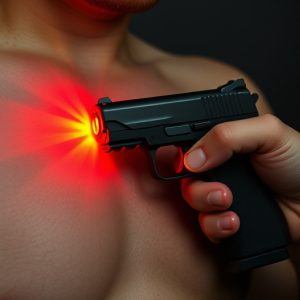Stun Guns Explained: Touchless Power for Personal Safety
Stun guns (electronic control devices or ECDs) temporarily incapacitate assailants with high-voltage…….
Stun guns (electronic control devices or ECDs) temporarily incapacitate assailants with high-voltage, low-current electrical pulses, disrupting muscle control. They operate through an electric field created upon contact with the target's skin or conductive materials. While direct skin-to-skin contact enhances shock intensity, modern models offer 'stun from a distance' capabilities for scenarios where physical contact is risky. Choosing the right stun gun involves understanding delivery methods (contact vs. non-contact), power output, safety mechanisms, and features like joule rating, LED lights, and sound alerts, considering whether direct skin contact is necessary for optimal performance.
“Uncover the power of self-defense with our comprehensive stun gun reviews. This guide explores the world of stun guns, demystifying their functionality and addressing key questions. Learn how these devices work, their benefits—including the controversial topic of whether they must make direct contact with skin—and discover essential features to consider when choosing a stun gun. Prepare to make an informed decision for your safety.”
What Are Stun Guns and How Do They Work?
Stun guns, also known as electronic control devices (ECDs), are non-lethal weapons designed to temporarily incapacitate a person through electric shock. They work by delivering a high-voltage, low-current electrical pulse into the target’s nervous system, disrupting muscle control and causing a powerful involuntary reaction. This results in temporary paralysis, allowing the user to escape or gain control of a potentially dangerous situation.
Unlike traditional firearms that rely on projectiles, stun guns use specialized technology to create an electric field. When deployed, the device makes contact with the target’s skin, either directly or through conductive materials like water, to complete the electrical circuit and deliver the shock. The process is non-lethal and aimed at temporarily neutralizing an aggressor without causing permanent harm, making them popular choices for self-defense and law enforcement applications, especially in situations where direct physical contact may not be advisable due to concerns about injury or when dealing with uncooperative individuals. One notable aspect of stun guns is that they don’t necessarily require direct skin-to-skin contact; they can still deliver a shock through clothing or other materials, making them versatile tools in various scenarios.
Benefits and Limitations: Does a Stun Gun Have to Touch Skin?
Stun guns are designed to incapacitate an attacker with an electric shock, but one common question is whether they must make direct contact with the skin. The answer is both yes and no. Modern stun guns use a probe or electrodes to deliver an electrical current, which can indeed cause a more powerful jolt if there’s good contact with the body. However, many models also offer what’s known as a ‘stun from a distance’ feature. This allows users to deploy the weapon without physical contact, making it effective in close-quarter situations where direct touch isn’t feasible or safe.
While this non-contact capability is advantageous, it does come with limitations. The shock might not be as intense as direct contact, and range can vary between devices. Moreover, certain environments or clothing could interfere with the stun gun’s effectiveness. For instance, using a stun gun on someone wearing a heavy jacket or in wet conditions may reduce its impact due to electrical resistance. Understanding these factors is crucial when considering a stun gun for personal safety, as it highlights the importance of choosing the right device for specific needs and environments.
Choosing the Right Stun Gun: Key Features and Reviews
Choosing the right stun gun involves understanding key features that ensure effectiveness and safety. One crucial consideration is the delivery method, which determines whether the stun gun requires direct contact with the target’s skin or can deploy an electric shock from a distance. Modern models often feature both contact and non-contact options, catering to different scenarios and user preferences. Direct contact stun guns deliver a powerful jolt through metal prongs or probes that make electrical contact with the target, making them highly effective for close-quarters situations. However, some users prefer non-contact stun guns, which use projected electric fields to disable aggressors from a safe distance, without the need for physical touch.
Reviews highlight the importance of power output, as measured in joules, and the consistency of shocks. A higher joule rating generally corresponds to a more powerful stun, but it’s also essential to consider the device’s safety features. Some models include LED lights or sound alerts that signal successful deployments, while others boast advanced safety mechanisms like automatic shut-off to prevent accidental discharges. User feedback also emphasizes the need for a compact and lightweight design, easy activation, and durable construction to withstand daily use and potential rough handling.


